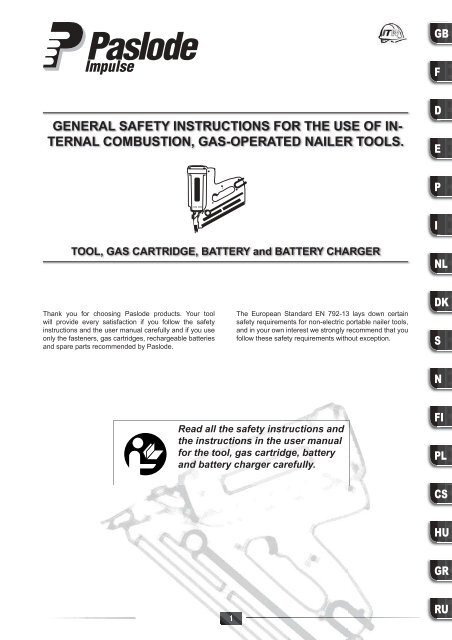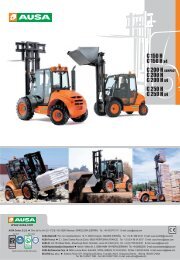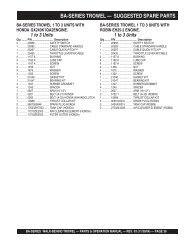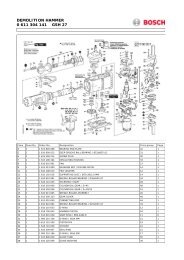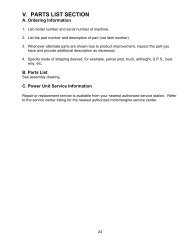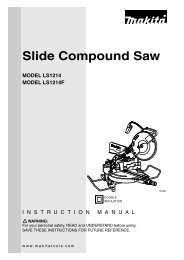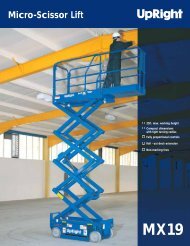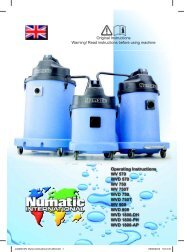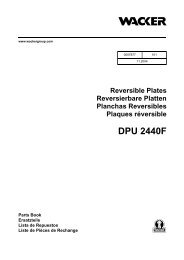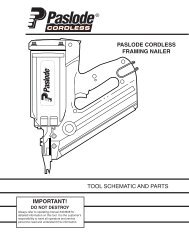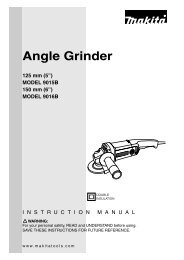Safety Guidance - JW Hire & Sales Ltd
Safety Guidance - JW Hire & Sales Ltd
Safety Guidance - JW Hire & Sales Ltd
You also want an ePaper? Increase the reach of your titles
YUMPU automatically turns print PDFs into web optimized ePapers that Google loves.
GB<br />
Impulse<br />
F<br />
GENERAL SAFETY INSTRUCTIONS FOR THE USE OF IN-<br />
TERNAL COMBUSTION, GAS-OPERATED NAILER TOOLS.<br />
D<br />
E<br />
P<br />
I<br />
TOOL, GAS CARTRIDGE, BATTERY and BATTERY CHARGER<br />
NL<br />
Thank you for choosing Paslode products. Your tool<br />
will provide every satisfaction if you follow the safety<br />
instructions and the user manual carefully and if you use<br />
only the fasteners, gas cartridges, rechargeable batteries<br />
and spare parts recommended by Paslode.<br />
The European Standard EN 792-13 lays down certain<br />
safety requirements for non-electric portable nailer tools,<br />
and in your own interest we strongly recommend that you<br />
follow these safety requirements without exception.<br />
DK<br />
S<br />
N<br />
Read all the safety instructions and<br />
the instructions in the user manual<br />
for the tool, gas cartridge, battery<br />
and battery charger carefully.<br />
FI<br />
PL<br />
CS<br />
HU<br />
GR<br />
RU
■ IMPULSE SYSTEM :<br />
GENERAL SAFETY INSTRUCTIONS<br />
■ The IMPULSE system is made up of:<br />
the tool, the gas cartridge, the battery and<br />
its charger, the set of fasteners. As regards<br />
safety, the tool, the fasteners and the<br />
gas cartridges referred to in the Paslode<br />
documents must be considered as a single,<br />
complete system.<br />
Eu ropean standard EN 792-13 : 2000<br />
(§ 7.2.5 a)<br />
■ Only the fasteners referred to in the<br />
operating instructions may be used with the<br />
machine.<br />
■ Only the lubricants and the main energy<br />
source laid down in the operating instructions<br />
may be used.<br />
■ For the maintenance of the machines,<br />
only spare parts specifi ed by the<br />
manufacturer or his authorized agent<br />
must be used.<br />
■ Only qualifi ed persons may use the<br />
Paslode Impulse nailing system. These<br />
persons must know perfectly how the<br />
tool works and must follow exactly the<br />
manufacturer’s instructions and the safety.<br />
They must be capable of carrying out the<br />
regular servicing on the tool.<br />
■ The tool must be checked before use. It<br />
must be loaded only just before it is used.<br />
If it is not used, it is essential to remove:<br />
the battery, the gas cartridge, the nails<br />
remaining in the magazine, and to put it in<br />
its original box.<br />
■ When using the tool, never point it at yourself or anyone<br />
else. If the operator has to move, the gun must be pointed<br />
downwards, taking one’s fi nger off the trigger.<br />
■ The tool must be used in a well-ventilated place. The<br />
inhalation of burnt exhaust gas (carbon monoxide) is a<br />
danger to health. Keep the tool away from heat sources as<br />
the gas cartridge could be damaged.<br />
■ Do not smoke when handling the gas cartridge, Keep the<br />
metering valve orifi ce away from your face and eyes. Do not<br />
inhale its contents.<br />
■ Only use the tool for the nailing applications for which it<br />
was designed by the manufacturer.<br />
■ At the moment of fi ring, the operator must be in a stable<br />
position, holding the tool as far as possible at right angles to<br />
the base material.<br />
■ The operator must ensure that there is no-one in the<br />
immediate vicinity of the fi ring area. Check the work place<br />
and environment.<br />
■ If a fi ring malfunction occurs, keep the tool on the work<br />
surface and fi re again. If there is another failure, remove<br />
the battery immediately and examine the tool. If several<br />
incidents occur, inform the manufacturer.<br />
■ When using the tool, the operator and the people around<br />
him must wear appropriate individual protection: goggles,<br />
safety helmet and ear protectors, etc.<br />
■ Never operate the tool resting on the fl at of the hand. The<br />
nailer must be operated only when it is in contact with the<br />
material to be fi xed. For thin parts to be fi xed, make sure<br />
that the tool is correctly adjusted and position it so that the<br />
fastener is aimed towards the base wood.<br />
■ The temperature of the burnt gases and of the tool may<br />
increase depending on fi ring frequency. Observe the use<br />
rates given on the data sheets and use gloves to avoid<br />
contact with the hot parts of the tool.<br />
■ The condition of the tool must be checked at least<br />
once a year by the manufacturer or his authorized agent.<br />
We recommend that you carry out regular maintenance<br />
(cleaning and greasing) so as to keep the tool in perfect<br />
operating condition.<br />
■ It is prohibited to make any modifi cation to the tool,<br />
gas cartridge or battery other than those specifi ed by the<br />
manufacturer.
■ GAS CARTRIDGE:<br />
The gas cartridge is an aerosol product corresponding to<br />
the 75/324/EEC and TRG 300 regulations. The cartridge<br />
contains:<br />
- liquefi ed hydrocarbon gases (butane, propane).<br />
- a lubricant for the piston.<br />
The propelling gas remains in the cartridge. The gas<br />
cartridge is always pressurized and must be protected from<br />
temperatures greater than 50°C. Its contents is extremely<br />
fl ammable.<br />
The gas cartridge is not reusable and refi lling is prohibited.<br />
USE:<br />
■ Warning : liquid gas can cause injury in the event of<br />
contact with the skin or eyes.<br />
■ Do not expose to sunlight and to temperatures exceeding<br />
50°C.<br />
■ Storage temperature: 5 to 25°C.<br />
■ Keep and use the cartridge only in well-ventilated places.<br />
■ Do not pierce or burn the cartridge after use.<br />
■ Do not spray towards a fl ame or an incandescent body.<br />
■ Keep away from any heat sources and from electrostatic<br />
charges.<br />
■ Do not smoke.<br />
■ Keep away from children.<br />
■ Do not breathe the gases.<br />
■ Do not refi ll.<br />
■ Dispose of only in designated places.<br />
■ For maximum performance, use before the date indicated<br />
under the cartridge.<br />
TRANSPORT:<br />
According to the international classifi cation, it is not<br />
necessary to have special authorization to transport<br />
gas cartridges. Below are the regulations by transport<br />
categories:<br />
- Road/rail: ADR – ADR - UN code 1950 class 2 code 5F<br />
- Sea : IMDG – UN code 1950 + risk sheet FD S-U<br />
- Air : IATA – UN code 1950 class 2.1<br />
- Transport by parcel post is not permitted<br />
- Transport of small amounts (< 30 Kg) in a private vehicle is<br />
permitted without a transport and safety sheet.<br />
STORAGE:<br />
- All local instructions corresponding to fi re regulations must<br />
be observed.<br />
- Stores and showrooms must comply with building<br />
regulations.<br />
■ Do not expose to a temperature exceeding 50°C, do<br />
not store in passageways and entrance halls and near to<br />
doorways.<br />
■ Good ventilation is always necessary.<br />
■ The cartridge storage area must not exceed 20m2.<br />
■ The numbers in sale rooms or showrooms must not<br />
exceed the numbers sold per day.<br />
■ Storage with other pyrotechnic products is not permitted.<br />
■ Display units must be away from exits. A class A,B,C 6 kg<br />
fi re extinguisher must be provided.<br />
■ Do not use tools with an incandescent device or which can<br />
reach high temperatures near to the cartridges.<br />
■ Gas cartridges must not be displayed in shop windows.<br />
3
■ BATTERY and BATTERY CHARGER:<br />
Before using the battery charging<br />
system, read the instructions and<br />
precautions indicated on the AC/<br />
DC adapter, the charger and the<br />
battery carefully.<br />
■ The charging system is designed to be used in covered<br />
places. Do not expose it to rain or to excessive humidity.<br />
■ Arrange the charging system so as not to walk on the<br />
cable or catch it.<br />
■ Do not use the system with a damaged cable or plug.<br />
Replace them immediately.<br />
■ To avoid electrocution risks, disconnect the power supply<br />
adapter before cleaning the terminals and contacts. Use a<br />
dry cloth.<br />
■ The adapter, the charger and the battery are designed to<br />
operate together. Do not use the charging system for other<br />
batteries or battery-operated tools.<br />
■ Do not store batteries at a temperature greater than<br />
50°C.<br />
■ Do not incinerate batteries.<br />
■ Do not use a battery charger which heats up excessively<br />
or gives off fumes when connected. Disconnect the charger<br />
immediately.<br />
■ Only charge one battery at a time on a charger.<br />
■ Batteries must be recycled or taken to appropriate places<br />
(collection containers according to local provisions).<br />
■ Do not put ‘Impulse’ batteries on charge on chargers other<br />
than ‘Impulse’ chargers.<br />
■ Do not short-circuit a battery. A high current could be<br />
produced causing overheating and destruction of the<br />
battery.<br />
■ Do not put a battery on charge if its temperature is less<br />
than 5°C or greater than 40°C.<br />
■ Do not put metal objects in contact with the battery’s<br />
terminals.<br />
■ Do not pierce or open the battery’s cells.<br />
4


